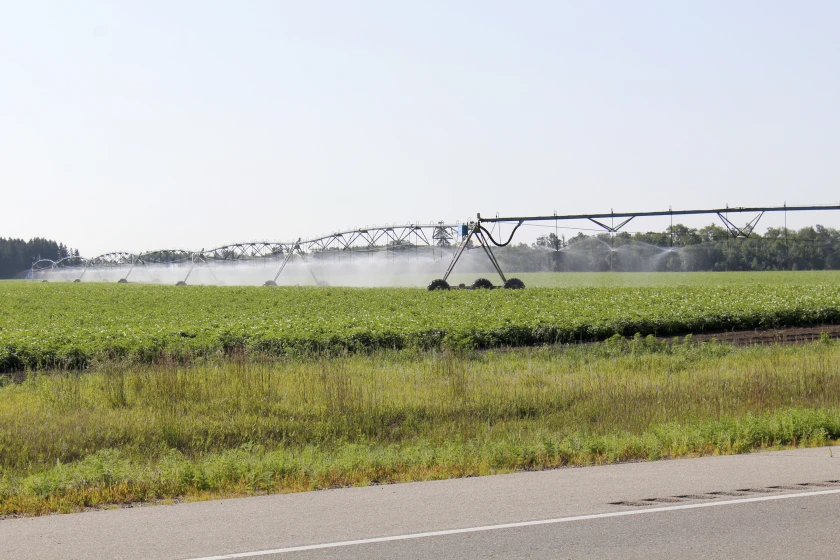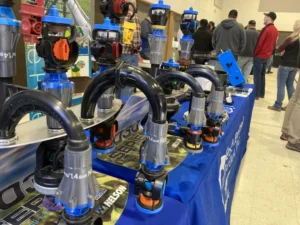
Originally Posted March 11, 2024 by AgWeek: Minnesota aquifer health depends on location and perspective – Agweek | #1 source for agriculture news, farming, markets | Above Image: An irrigation system sprays water on a potato field south of the Lamb Weston/RDO Frozen plant in Park Rapids. Robin Fish / Forum News Service
Central Minnesota irrigators reviewed data showing that their aquifers remain in good health. That’s positive news for those areas, but not all areas of the state have reason to celebrate.
Minnesota irrigators were asked to tell their story at the Irrigators Association of Minnesota annual convention in February. Within their story, they were asked to tell the public that what they are doing to grow crops across hundreds of thousands of acres of farmland is, in many cases, not affecting aquifer levels.
Larry Kramka is an engineering consultant with The Foth Company out of Duluth. He shared public DNR data from three different areas of the state, each with high densities of irrigation wells. Across those three areas, including Perham (in west central Minnesota), the Bonanza Valley (in central Minnesota) and within Dakota County (south of the Twin Cities), average aquifer levels were largely unchanged over 30 years of reporting. That’s from data available publicly from the Minnesota DNR.
“The trend is flat,” Kramka said. “Essentially, no change.”
That was music to the ears of producers in the room who have been fighting against a narrative that says irrigators across the state and country are wreaking havoc on water supplies .
The areas that Kramka chose to illustrate happened to be areas with some of the highest Irrigators Association of Minnesota membership, so it was very valuable information to the crowd of water users. Irrigators Association of Minnesota president Jake Wildman admits he’s not a hydrologist but he recognizes that Minnesota farmers are blessed to live in a land of so much water. From what he is seeing, most Irrigator Association members are doing what they can to conserve water and most are not seeing water supply concerns in their areas.

“Minnesota’s long-term sustainability of their aquifer health, we’ve realized through some looking at data, from the DNR, from their groundwater observation wells, is that our overall health of our aquifers in the state are good,” Wildman said. “We have actually found some areas that over 30 years the trend is up … and a lot of them are flat, and they are not going down.”
Jason Moeckel, Minnesota DNR section manager for the Ecological and Water Resources Division, was also in attendance at the conference and said that those average numbers Foth shared were one indication of the health of the aquifer, just not the full picture.
Moeckel said the state has 404 wells with 20 years of data to analyze. Among those were 17 buried aquifer wells that did show a trend of lower water. The buried aquifers are those not necessarily connected to surface water, but are important for consistent underground well pumping. What’s concerning about any amount of water loss in the state’s aquifers is that it comes at a time when the state has been experiencing more moisture in general.
“Our climate data tell us that the last 30 years have been the wettest 30 years on record,” Moeckel said.
The Minnesota DNR concluded in their Water Availability and Assessment report in 2020 that “compared to 20th-century averages, all of the 10 wettest and warmest years on record occurred after 1998.”
Moeckel said that if the state has aquifers showing downward trends, while experiencing more rainfall on average, “we should take a closer look at those sites.” While there may be more precipitation, there is also more groundwater use, nearly 3 billion gallons more each year.
Both Moeckel and Kramka shared that there are some areas of the state experiencing low water situations that are concerning and others that are not so concerning. Kramka noted an area near Marshall and another area near Crookston where there is a lack of water availability. Moeckel brought up the extensively studied Little Rock Creek area.
“There’s water availability issues around Crookston,” Kramka said. “It doesn’t mean that we can’t manage it and it doesn’t mean that we use Crookston as that surrogate for everywhere else. We shouldn’t.”
Within the DNR’s Water Availability and Assessment report is data showing that from 1985 to 2019, some water use was actually down in the state. The largest portion of Minnesota’s water use from surface water is for power generation. There’s been a decrease in that water use attributed to a decrease in water needed for power plant cooling — a use reduction of 33% from 2005 to 2019, according to the DNR.
Irrigator users have also attributed to decreases with conservation methods like soil moisture sensors that more accurately show when water is needed on crops.
Much like Kramka’s examples of localized areas that appear to be unharmed by extensive irrigation, Moeckel said there are localized areas that are concerningly low and proper actions should be taken in those areas.
On another note, Moeckel said looking at average water levels gives one picture but does not take into account the lowest lows or highest highs being recorded. If the lowest lows are lower than ever before, he said that’s not something to ignore.

Minnesota irrigators want it to be known that they are making strides to use water wisely. Wildman shared that today’s irrigating farmers are using the latest technology to conserve water. He mentioned weather prediction models, soil moisture monitoring and evapotranspiration gauges being used by modern farms. These were mostly nonexistent just 10 years ago.
“I think we’re going to continue to get better,” Wildman said. “We do a really dang good job with what we do, with the tools we have,” Wildman said.
The big message that DNR staff like Moeckel hope to get across is that aquifers respond slowly to changes in climate patterns, but they respond fairly quickly to pumping.
“We can’t think about this as a statewide question. We really have to focus on local geographies, to understand what’s going on. Are there concerns? What’s the significance of the magnitude of those concerns? What sort of adjustments might be needed or not?” Moeckel said.
The “Land of 10,000 Lakes” is blessed with abundant water, as Wildman said, but how that water is used varies significantly across the state. One clear thing is that not everyone can tell the same story about what is or isn’t working.
Related News and Events
Randy Homel Selected to Receive Rotary Club of Green Bay 2025 Free Enterprise Award

